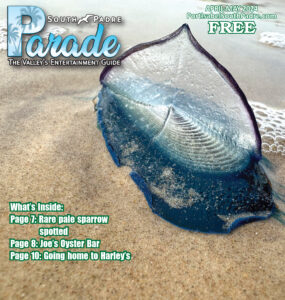 By JAVIER GONZALEZ
By JAVIER GONZALEZ
Special to the PRESS
The tides have a profound effect on Coastal habitats. The force of the water as it rises into (flood tide) and falls out of (ebb tide) the salt marsh and salt flats stirs up a great diversity of micro and macro organisms that in turn trigger a feeding frenzy up the food chain. Tides are created by the gravitational forces laid upon the earth by the Sun and Moon, but since the moon is the closest to Earth, it is the major factor in the intensity of the tides through its monthly lunar cycle. The most extreme tides with the largest range between high and low water are the “spring tides” and they occur just after a new and full moon. Spring tides occur twice a month and the term “spring” is not in reference to the season, but rather derived from the concept that the tides “spring forth”. During a new and full moon the Sun and the Moon come into alignment and their combined gravitational forces create a bigger bulge on the ocean and therefore a higher tide. During the spring tides, the flood tide comes up deep into the South Padre Island Birding and Nature Center salt flat and leaves a greater part of it inundated for a good while. As the water rushes into the flats it brings with it fish and other small organisms. A great number of birds take advantage of this easy feeding opportunity and in turn visitors to the center get to enjoy a higher diversity of bird species on the salt flats. Lots of waders, plovers, terns, gulls, and a few of the first shorebirds of the fall migration have been seen enjoying the high tide water in the days around and during the spring tides lately. Experienced anglers understand that knowing how to read the tides could help them have a more productive fishing outing, but the same can apply to birding in coastal habitats.

Another factor that comes into play is location. While the high tide seems to be good for birding at the SPIBNC salt flats, the same might not be true in other spots. Some areas that are generally too deep for the birds could be more productive during the low tides when the water is shallower and more shoreline is exposed. Knowing how the tides affect different areas along the coast can help in determining when the best times to visit each site might be. For example, birding the SPIBNC salt flats from Bird Blinds #1 and #2 is best during the high tide, but birding just west of the mangrove line from Bird Blind #3 is best during the low tide when there’s more shoreline exposed.
This month’s full moon happening August 18th will bring a pretty powerful spring tide that should make for a great week of birding on the South Padre Island Birding and Nature Center salt flats! Join us for the fun on one of our bird walks! Keep up with the tides by reading the tide charts elsewhere in this publication.
Want the whole story? Pick up a copy of the Port Isabel-South Padre Press, or subscribe to our E-Edition by clicking here.
Related
 By JAVIER GONZALEZ
By JAVIER GONZALEZ


Comments